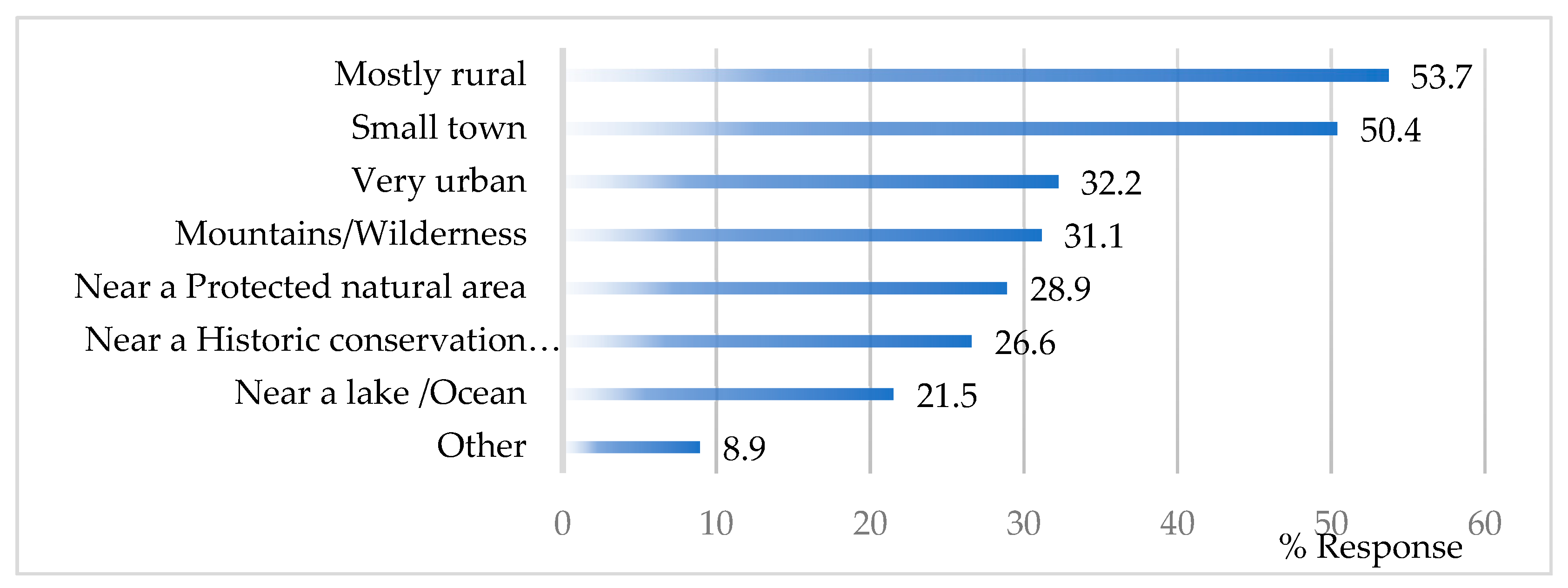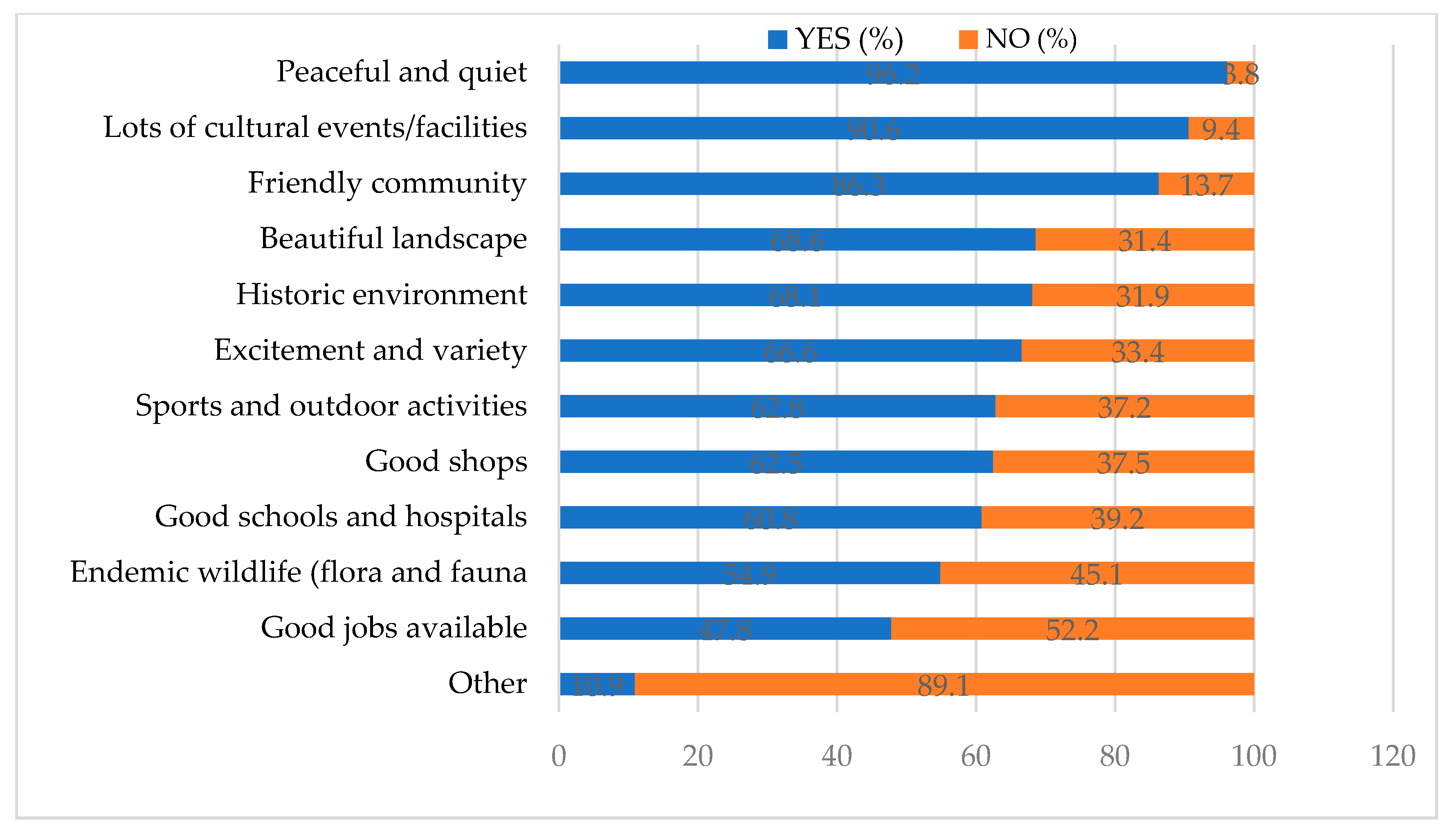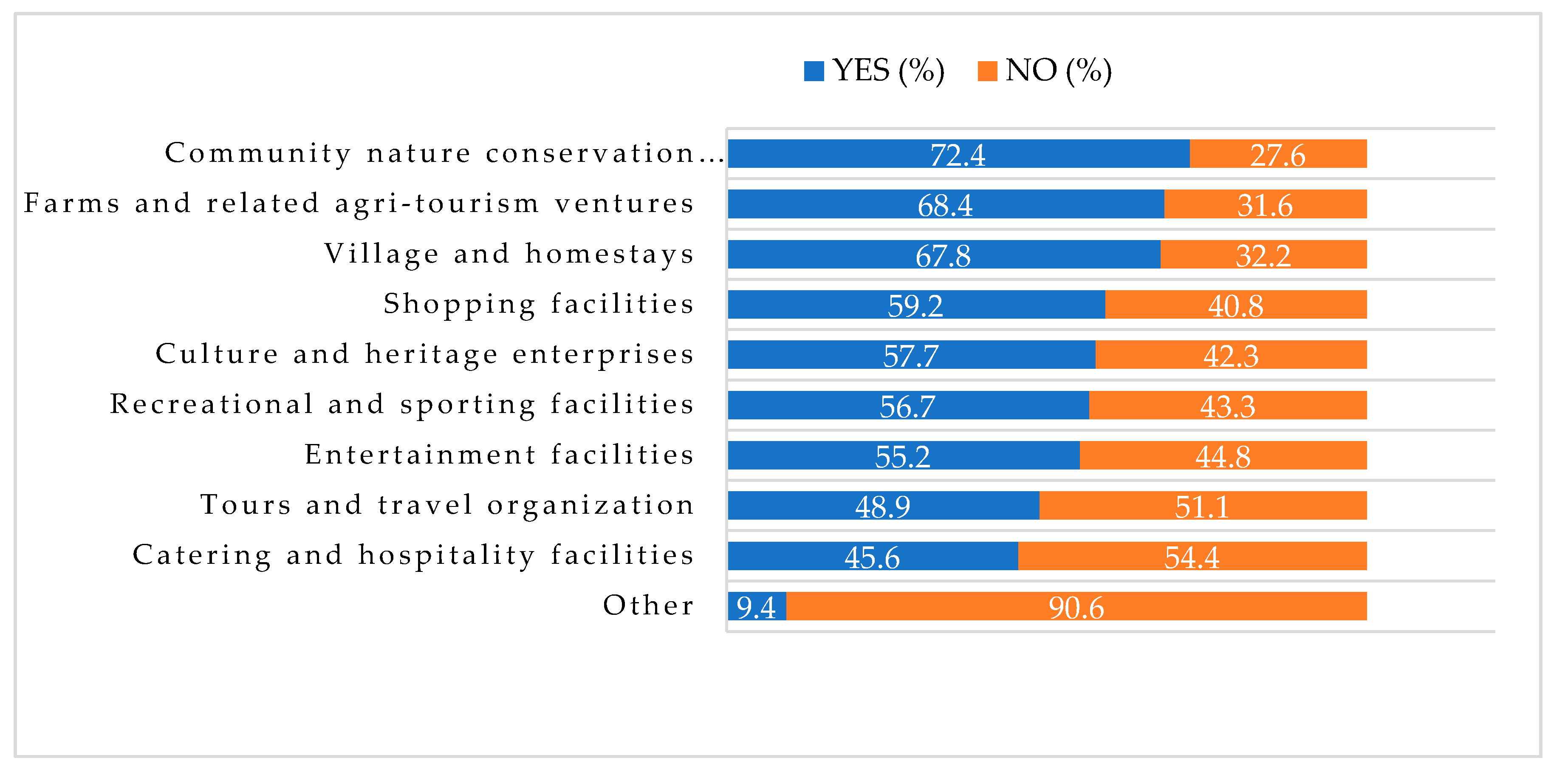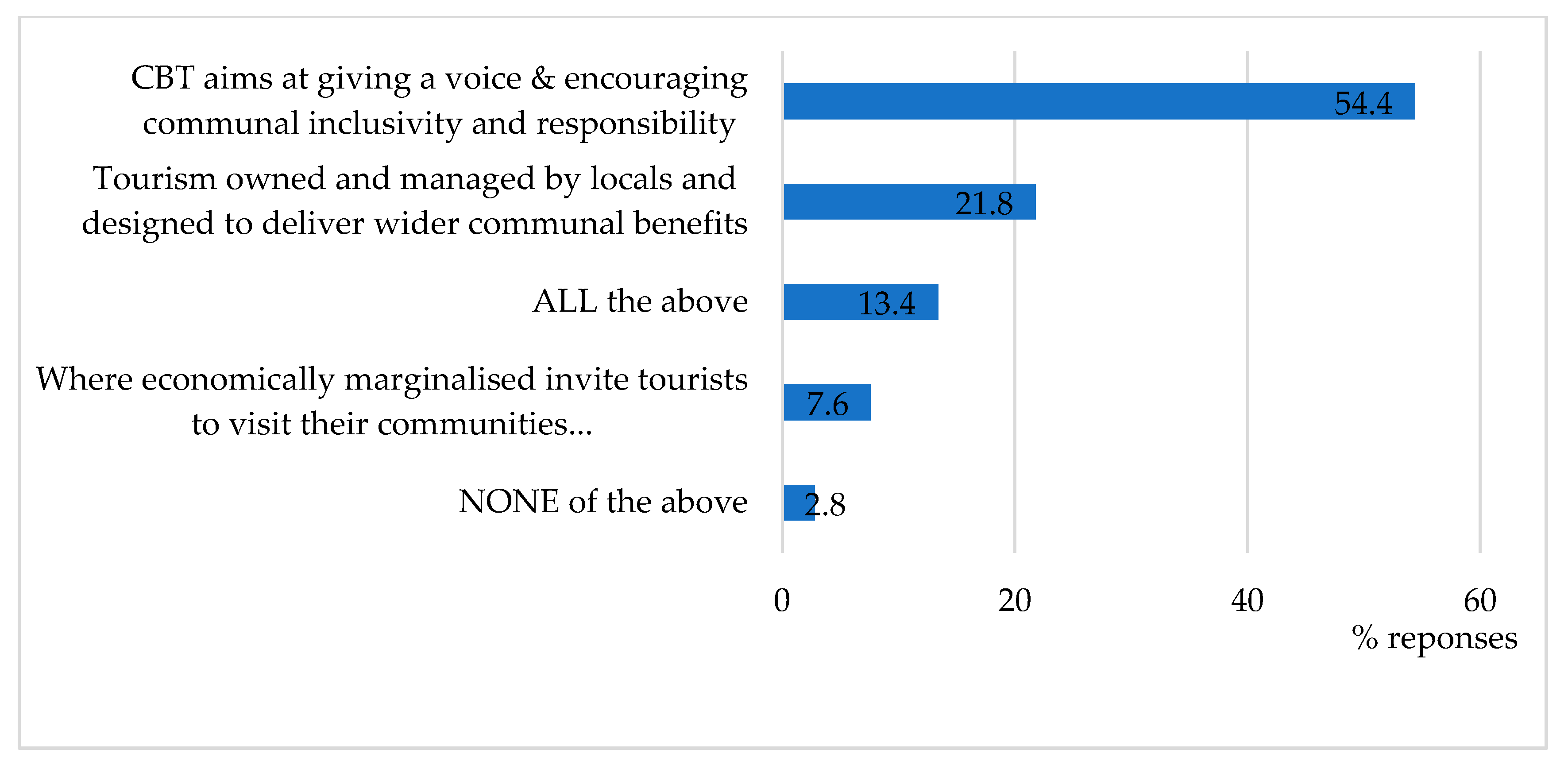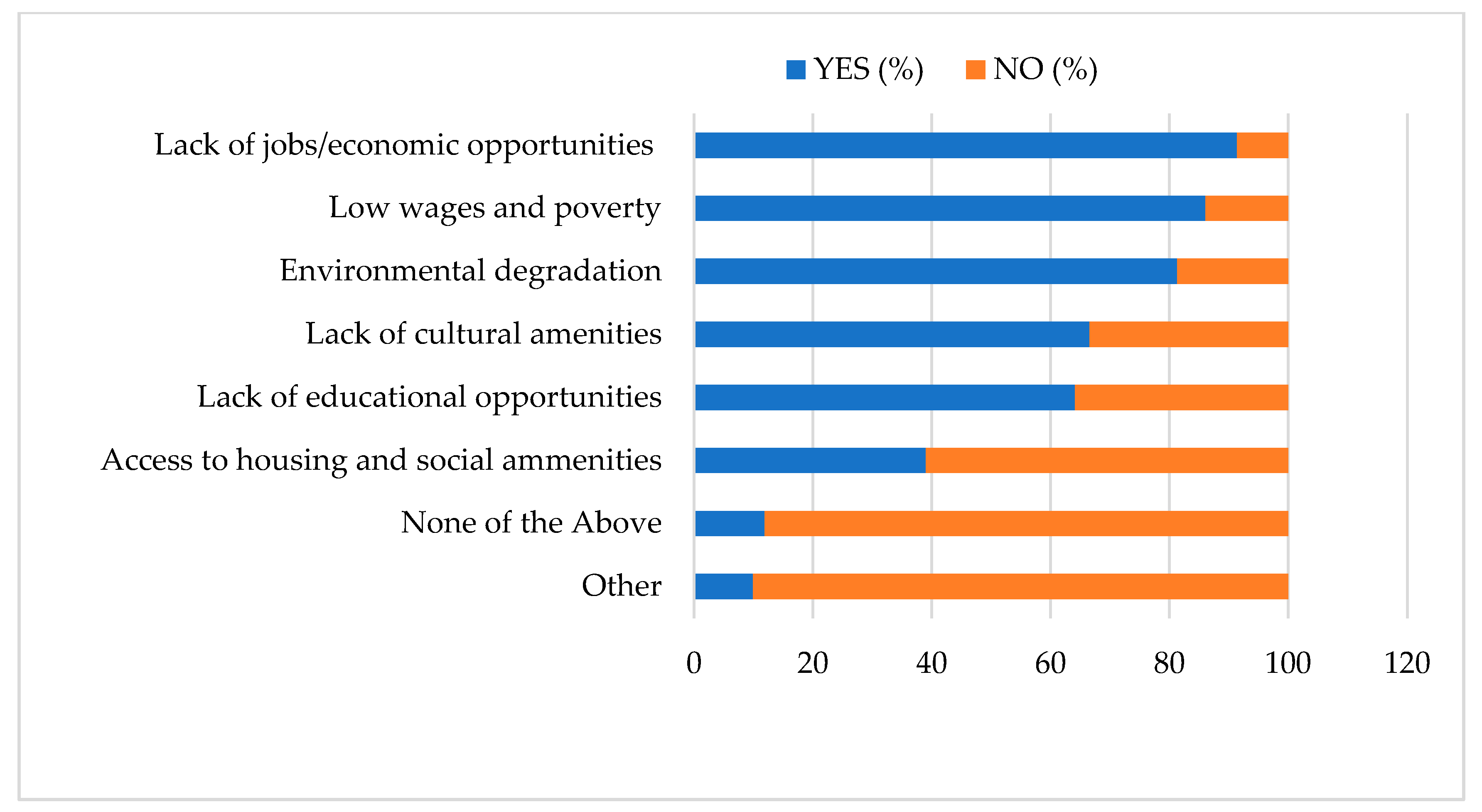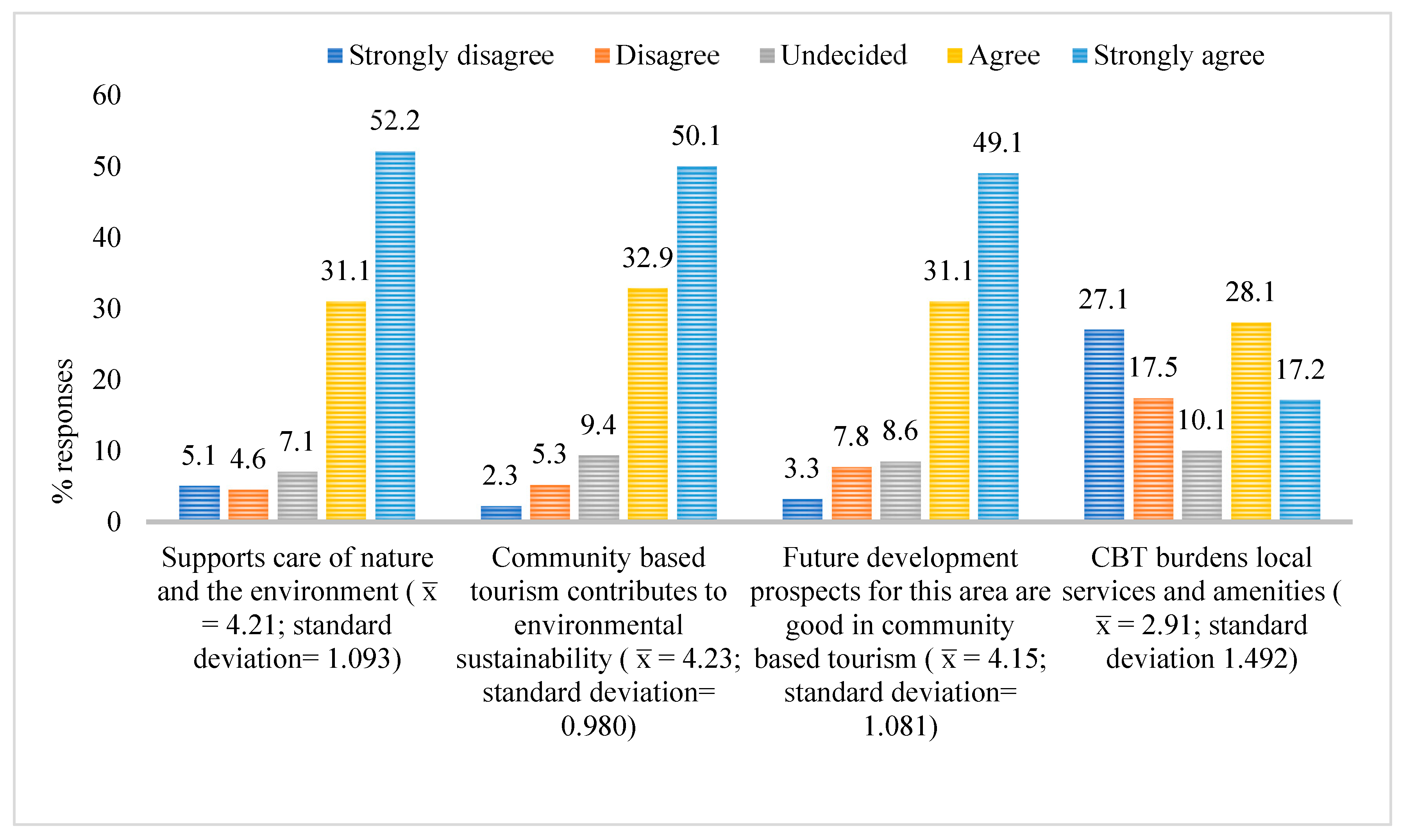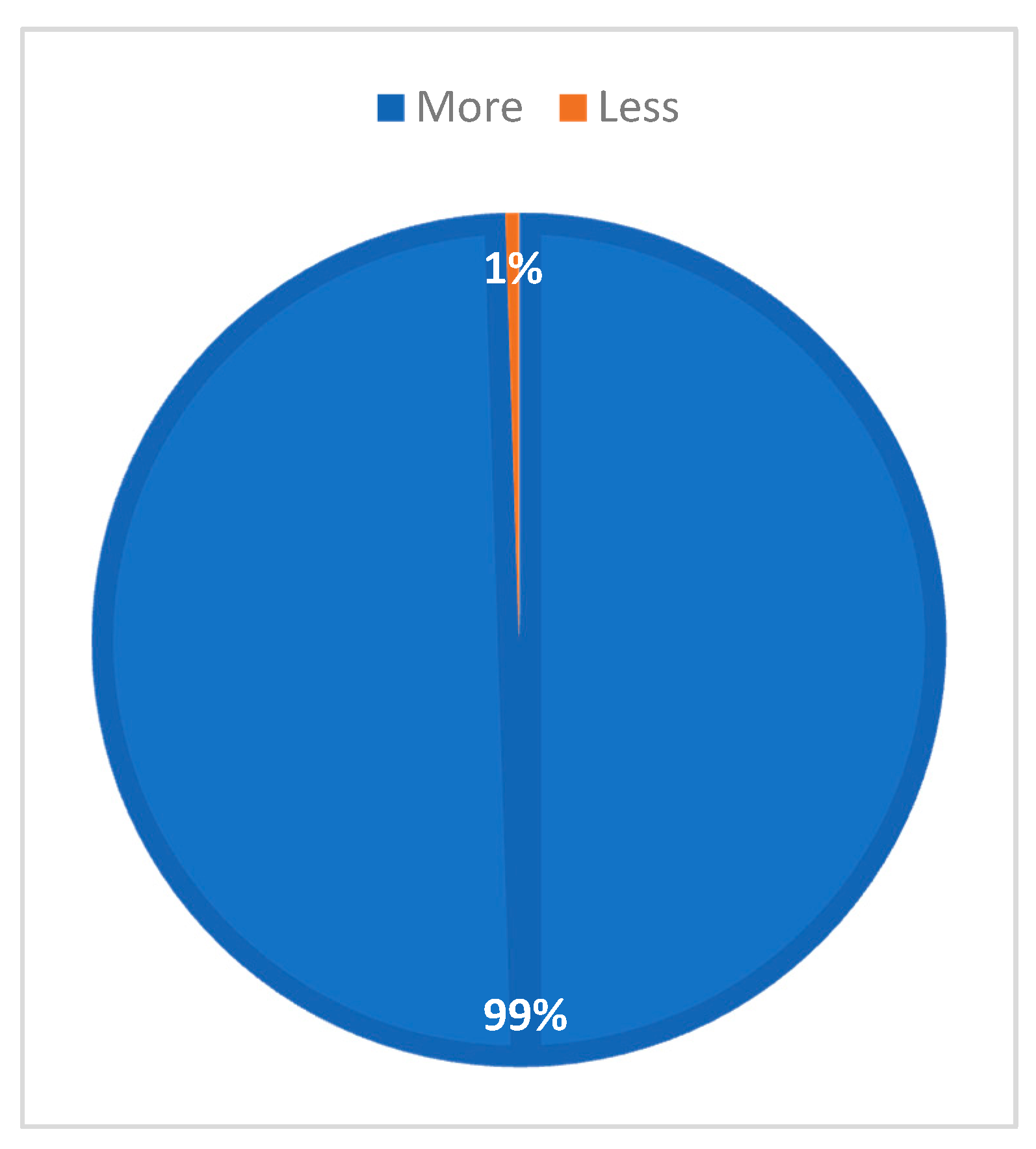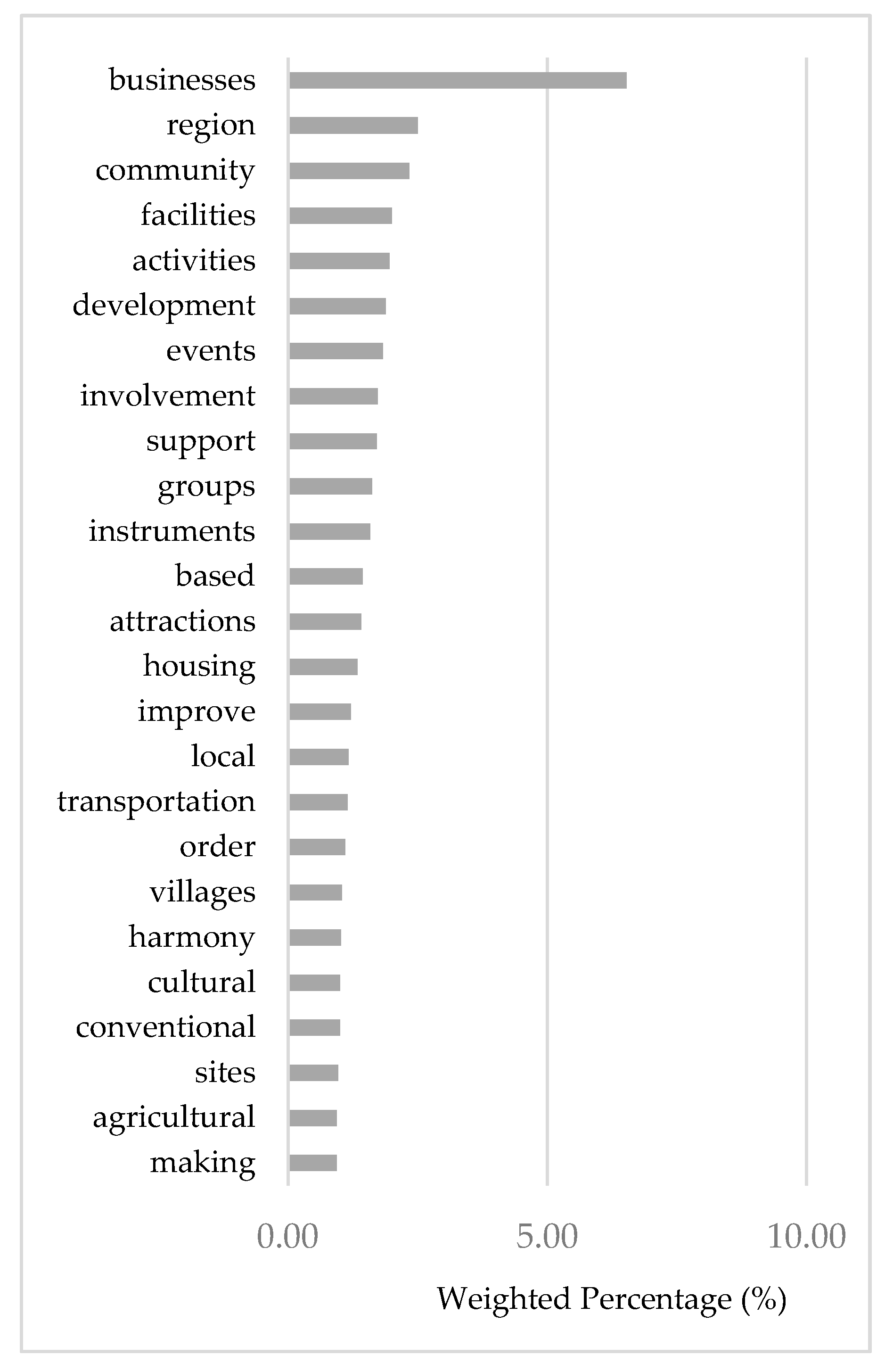1.1. Sustainable Development and Community Based Tourism Revisited
Kenya has experienced one of the fastest population growths, from 7 million to an estimated 52.2 million with global rankings soaring from 57th in 1955 to 27th in 2019, respectively [
1]. At present, over 80% of the population depends on agriculture with about 73.4% of this population being in rural areas and a further 40% being employed in agriculture, an economic activity that greatly depends on land and associated resources [
2]. As the population grows, natural resources become scarce and increasingly subject to a lot of pressure as communities and their governments strive to achieve local and national socio-economic development goals. Certainly, a fast-changing human and socio-economic environment regularly presents many challenges to the country’s sustainable development. In this regard, futuristic development planning and governance are envisaged to guarantee the sustainability of scarce resources and at the same time securing sustainable livelihoods for the present local populace. Indeed, without sustainable livelihoods, the future of scarce resources is also put at risk.
Sustainable development is not a new phenomenon, being derived from the famous Brundtland Commission report of 1987 titled “Our Common Future” [
3]. Despite the existences of several definitions, it is now widely viewed as: “development that meets the needs of present generation while protecting and enhancing opportunities and possibilities for the future generations” [
4,
5]. Indeed, sustainability forms the basis for contemporary international cooperation frameworks such as the 2030 Agenda for sustainable development and its Sustainable Development Goals [
3]. Nevertheless, despite the general recognition of sustainable development as a growth model, its application is still a challenge. Some scholars view sustainable development as an oxymoron and similarly sustainable tourism as an excessively narrow concept for sustainability [
6,
7,
8].
These arguments notwithstanding, communities in rural regions certainly depend on different sources of livelihoods and sustenance systems as defined by resource availability or access, character of the regions they live in and as dictated by their culture. The socio-economic activities practiced by a local community therefore are diverse and can include cultivation agriculture, animal husbandry, informal cottage industries, tourism and hospitality activities, small- and medium-size retail enterprises, and financial services scattered throughout rural regions. Most, if not all, of these economic activities compete over land and related resources and therefore require integrated development and management to sustain the livelihoods of the rural populace [
9].
Tourism as a tool for development was first promoted in the 1970s; however, in contemporary societies, focus has been on the role of ecotourism, pro-poor tourism and Community-Based Tourism (CBT) [
10,
11]. The concept of CBT first appeared in the work of Murphy [
12], in which tourism issues and its impact on local communities in developing countries were analyzed. CBT is characterized by the fact that it is the community itself which has control over tourism management and gets a significant proportion of the benefits generated by such activity [
13,
14]. Thus, this kind of tourism has emerged as a possible solution to the negative effects of mass tourism in developing countries, allowing it to simultaneously become a strategy for social organization for the local community itself [
14]. On the other hand, Armstrong [
15], viewed CBT as “tourism owned and/or managed by communities and intended to deliver wider community benefit”, and should offer opportunities for local economic development and poverty reduction. Armstrong [
15] continued to observe that CBT has received significant endorsements as a sustainable development tool for a number of reasons. First, it should make a positive impact on the conservation of natural and cultural resources in regions. Secondly, CBT must bring socio-economic development in the local community. Thirdly, there must be an increase in the number of businesses whose ownership is in the hands of the local community through appropriate planning and management of tourism. Finally, high quality visitor experiences must be established for tourists visiting the area. In this regard, therefore, the CBT concept has presented new lines of research and opportunities for tourism development: Pro-Poor Tourism (PPT) to specifically fight poverty in certain areas; Community Benefit Tourism Initiatives (CBTIs) to deal with the need to search for benefits for the whole community, independent of other socio-political issues, ensuring that the community owns, manages and controls the projects [
10,
11,
13]; and Donor-Assisted Community-Based Tourism (DACBT) [
10,
11].
It is imperative to note that tourism is multifaceted in nature and has strong back and forth intersectoral linkages and multiplier effects that promise enormous potentials for marginalized regions in the least developed regions and countries [
16,
17]. In this regard, while destination managers endeavor to develop tourism in marginalized or rural areas, marketers are keen on the attributes that create destination appeal and affect traveler’s choice [
18,
19]. An attractive tourist destination can thus be built based on the inherent characteristics of a region, which, among others, include quiet and peaceful environment [
20], diversity of active sports and outdoor activities, cultural events, shopping, a friendly and hospitable community, beautiful landscapes and associated biodiversity [
18,
21,
22].
One of the key elements in countryside tourism development is to inspire wider local community involvement to serve as a foundation for the sustainability of the tourism destination and industry thereof [
23,
24]. Although literature suggests that local communities play several roles in local tourism development, very little attention has been given to establish how local communities feel about their involvement [
25,
26,
27]. Nevertheless, community involvement is a critical component of sustainability. In fact, natural resource management experts assert that community-based resource management is a process where locals gain access and user rights to land and related resources, or ownership of local resources, and the use thereof to achieve individual or collective financial and other benefits through stewardship [
28]. In the same vein, CBT, viewed as a community-based natural resource management system, endeavors to allocate full or partial rights, ownership and/or control over resources to a section or the whole local community. The aim is to boost revenue streams and livelihoods for poor people in rural areas through better governance, empowerment, and increased economic returns from tourism and natural resource management initiatives [
27,
28,
29,
30,
31].
In this regard therefore, CBT is considered as a situation where locals own, and/or have access/use rights to tourism resources and activities for their individual or equitable community benefit through stewardship [
32,
33]. In the Republic of Kenya [
4], CBT is a form of tourism that is dependent on community owned or managed resources through communal stakeholders, or carried out by individuals, from within a community, providing equitable returns to the wider community for using these communal resources. In the context of rural regions, these resources are diverse and are not limited to agricultural resources, forests, wildlife, water and fisheries, cultural heritage, infrastructure and the built environment that are collectively used and managed by individuals or a group of people with equitable sharing of benefits [
34]. Consequently, this diversity of resources has rendered different forms of community-based tourism enterprises, which include community ranches and nature conservation ventures, culture and heritage enterprises, village and homestay tourism, agri-tourism ventures, shopping and entertainment facilities, catering and hospitality facilities, sporting and recreational facilities, and tours and travel organization firms [
35,
36].
The aforementioned resources and activities renders Community-based tourism to be diverse in form, nature, and scale of operation, and that it not only relies on natural resources owned and managed by the locals but also on social and cultural heritage, and economic activities such as agricultural production, all of which constitute a community’s general way of life. When these resources are packaged to travelers as tourism products to benefit local and resident communities individually and collectively through equity, this constitutes CBT. Surrogates to CBT include aspects of village tourism, homestays, rural tourism, countryside tourism, cultural tourism, wildlife conservancy tourism, agri-tourism, and ecotourism [
37,
38,
39,
40,
41]. The diverse nature of CBT provides varied opportunities and carries immense potentials in product and experience offerings to the local populace as well as the traveling public to remote and possibly marginalized locations. In fact, it can be argued that CBT initiatives and products are rarely standardized and therefore each destination and product will always deliver unique experiences with little or no possibility for product substitution.
CBT through community-based resource management combines conservation objectives with income generation activities for the local communities. This resource management approach delivers both ecological and economic advantages. First, it provides an opportunity to generate income amongst locals, and, secondly, enhances cohesion and integration by creating an enabling ecosystem for rural governance and empowerment to the extent that communities see themselves as managers of their resources through direct control, active participation in decision making [
10,
34]. In addition, CBT has also been viewed to espouse the tenets of environmentally friendly tourism that are culturally appropriate, ecologically sustainable and economically viable. Consequently, in several situations and localities, CBT has been endorsed to promoting conservation, providing beneficial and active socio-economic involvement of local populace and the diversification and economic development of destination areas [
3,
7,
11,
13,
17,
25]. In return, CBT generates income for conservation and the management of natural attractions, public land as well as employing local people, and creates increased awareness and pride in the local community. On the other hand, induced activities such as village visits for living culture, cultural performances, and souvenir production employ unskilled labor and therefore CBT can redistribute income to the poor thence reducing poverty in rural regions [
42].
1.2. Global Perspectives of CBT and Sustainability of Rural Regions
The study conducted a critical review of researches carried out around the world to gain a clear understanding of the CBT concept and its contribution to the sustainability of rural regions in various countries. For instance, a research carried out in Romania raised concerns about the complexity of the term “community” when dealing with CBT initiatives. Thus, the term community was noted to present the difficulty of translating into practice the paradigm of CBT [
38]. This evokes the notion that community constitutes a wide array of a region’s actors and stakeholders that together with external actors through networks of tourism initiatives produce benefits for communities. Thus, to deliver its potentials for local area development, CBT requires the involvement of diverse actors including local authorities, associations, non-governmental organizations, and the wider private sector players [
43]. Further to these arguments, research carried out in Croatia asserts that CBT should be developed through a holistic and comprehensive approach with emphasis on an all-inclusive community participation at all levels of development. Indeed, if developed well, CBT can significantly improve the circumstances of local communities through empowerment and promoting greater economic and social benefits to individuals and organizations [
44].
In the context of Brazil, CBT is perceived to promote community development by connecting income generation, social inclusion, gender equity, and environmental sustainability [
45]. In CBT projects, therefore, different socio-cultural community groups with distinct roles, concerns, and priorities collaborate to manage tourism activities. To ensure inclusivity, community groups are defined by gender, age, birthplace, level of education, participation in tourism associations, type of income-generating activity, tourism occupation, and lastly years of experience in CBT [
45]. In view of these, it can be argued that without inclusivity and benefit sharing, perpetual continuity of CBTEs will be jeopardized as disagreements, strife and disintegration set in. Based on earlier research carried out in Squamish, Canada, Reed [
46], endorsed this viewpoint by noting that power relations can affect CBT development and that they exist in any emergent tourism settings. Thus, CBTEs and their external stakeholders should create an enabling ecosystem for CBT operations to flourish, which could be done through regulation, capacity building, infrastructural development, security provision, investment promotion, concessions and leases which are viewed as foundational for any regional development strategies. Indeed, since the inception of CBT, governments, development agencies and NGOs have placed considerable emphasis on CBT as a development model [
47].
On the contrary, research carried out in Nicaragua indicates that CBT has been criticized with respect to the low economic impact in terms of jobs and income generated, its small-scale interventions, its short life expectancy after external funding ends, the monopolization of benefits by few local elites, or the lack of business skills to facilitate perpetuity of CBT enterprises (CBTEs) and operations [
47]. Therefore, the CBT model in Nicaragua sought to support socio-economic development and poverty alleviation with a shift from over reliance on donors and policy-makers towards redistribution policies that strengthen the skills, resources, and conditions of micro, community-based and family entrepreneurship, together with a stronger orientation towards the domestic markets [
47]. Nicaragua CBT model exploited the basic social structure of a community where social capital, trust, commitment and mutual benefit is the focus among its membership, as endorsed by other scholars [
48].
Certainly, while using the social–ecological resilience theory, research carried out in Ecuador observed that, although sustainability is one of the major challenges facing tourism, sustainable development can only be achieved in sufficiently resilient socio-ecosystems, which is a significant element of community-based tourism [
48,
49,
50]. Sustainability from a resilience theory standpoint is the possibility that an existing system of resource use will persist indefinitely without a decline in social and natural resource bases [
48,
49]. Further research in the Dominican Republic observed that communities should invest in strengthening social bonds, developing capacity in local institutions, in diversifying the tourism product and controlling infrastructure development [
51]. The research established that trust, networks, local control, flexible governance, leakage prevention and controlled infrastructure development are key in assessing social–ecological resilience and sustainability [
49,
51].
As with most other countries, international tourism is a vital source of foreign exchange, employment and an important feature of the Laos Democratic Republic government’s poverty reduction strategy [
52]. Several development partners have financed many infrastructural projects facilitating tourist movement in the Lower Mekong Basin as well as supporting CBT projects to provide touristic experiences and services. These CBT projects have been observed to afterwards alleviate poverty and develop financial and cultural capital, stir local investments and eventually the development of marginalized regions of the Laos Democratic Republic [
10].
Over the last two decades, the development of tourism in rural areas has become a central approach to stir the economy and social development of marginalized areas as a poverty alleviation strategy in most countries. In fact, according to Yang [
52], China, the most populous country in the world, has adopted CBT activities and initiatives to secure and improve people’s livelihoods, using a model tourist village in the countryside. These observations have been echoed in the Southeast Asian nation of Cambodia, where findings show that CBT projects are positively contributing towards community development. Nonetheless, these researchers asserted that CBTEs financial sustainability, business practices and community support should be improved to optimize returns to rural and remote regions [
52,
53]. On a similar note, Armstrong [
15] added that the principal conditions for CBTEs success and sustainability include engagement with the private sector; a strong and cohesive host community; genuine community participation, ownership and control; planning for commercial viability; sound market research and demand-driven product development; attractive, quality products based on community assets; transparent financial management; appropriate stakeholder support; and effective monitoring and evaluation. It is vital to note that sustainable CBTEs equals sustainable livelihoods and consequently sustainable development of regions.
On the African continent, since the 1970s, most countries have experienced exponential growth in tourism [
54]. This growth in visitor numbers has not necessarily always translated to economic, social or environmental benefits for host communities. Nonetheless, the Kenya Community Based Tourism Network (KECOBAT) [
55] notes that the, concept of CBT is widely practiced in southern Africa and Namibia with many success stories [
54]. An in-depth field study in one of Namibia’s rural areas established that tourism incomes captured locally improved the livelihoods of rural households and generated linkages in the local economy [
56]. In this regard, therefore, the Government of Namibia has acknowledged CBT as a tool for sustainable development of its marginalized regions [
57].
These findings have been replicated in Cape Verde, where CBT has not only been used as a strategy for local socio-economic development but has also been recognized as an alternative to traditional mass tourism [
14]. The researchers further noted that CBT allows for greater contact with local residents and generates greater economic and environmental benefits for the local community. Thus, in the Cape Verde perspective, the quality of tourism resources provided by local businesses and the community’s hospitality are key elements for the development of CBT.
Research carried out in Tanzania also resonates with other global and regional findings that the CBTE strategy can be used by developing countries to alleviate poverty and meet their regional development challenges of job creation, income generation, community cohesion, community development, inclusion, and empowerment [
58,
59]. Mgonja et al. [
16,
59] further observed that CBTEs in Tanzania’s rural regions differ greatly in terms of structure, size, development level and resource capacity, and that many lack clear benefit-sharing mechanisms. It is vital to note that lack of clear and equitable benefit sharing systems can ostensibly lead to disagreements, strife, or splinter groups and finally collapse of CBTEs [
32,
34,
45]. This challenge in addition to poor CBT management threatens the sustainability of CBTEs and the benefits they portend to the sustainability of rural and/or marginalized communities and regions.
Furthermore, in Uganda, CBT has repeatedly been endorsed as an alternative to high volume mass tourism which can potentially be used as a strategy to reduce poverty, a highway to not only improved quality of life, but also greater empowerment and economic benefit to individuals and local communities, and thereby helping resolve regional disparities [
60]. Despite these accolades, research carried out in Rwenzori Mountains of Uganda established that alpine CBT has failed to reduce regional income disparities and promote sustainable development because the broader community does not benefit from communal ventures [
61].
Kenya is one of the leading destinations in Sub-Saharan Africa mainly known as the home of
Safari—a journey to various wildlife habitats to experience nature, witness the wildlife spectacle and open wilderness, enchanting beaches and an interaction with the indigenous communities. These notwithstanding, Kenya has not been left behind in endorsing CBT as a tool for socio-economic development albeit with a few challenges [
62,
63,
64,
65,
66]. Magayu [
67] observed that Kenya, along with many other governments of developing countries in Africa, have advocated for CBT as the preferred contemporary model for tourism development that also serves as a key catalyst for economic regeneration and poverty eradication. According to Gaitho [
32], and Manyara and Jones [
68], CBTEs in Kenya have mainly taken a culture and nature conservation orientation with support agencies preferring partnership approaches involving external investors who inadequately address community priorities.
In fact, Akama and Kieti [
69] pointed out that Kenya’s tourism industry is largely characterized by external control and management of tourism establishments with limited local involvement and high leakages; therefore, the industry does not play an effective role in local socio-economic development. While it may be helpful to have external actors during the initial stages of CBT ventures, the domineering influence of foreign actors, especially when they engage in direct competition with local communities, can work against the attainment of holistic community development and may result in losers and winners [
70,
71]. Local communities often become losers given the power, financial, experience, capacity and resource differentials between multinational operators and local communities [
71]. In view of these, researchers argue that, to fully optimize benefits for local communities, challenges facing CBT must be addressed [
69,
70,
71,
72]. For instance, CBT development in Kenya should adopt a “people centered” approach aimed at sustainability and diversity as opposed to conservation alone [
66,
72]. Indeed, given the importance of CBT as a tourism development strategy in Kenya, the government through its Ministry of Tourism and Wildlife has formulated a CBT development framework, and legal and institutional structures to support the sustainable development of tourism throughout the country [
63,
64,
65]. This is informed by the fact that tourism has contributed significantly to employment creation, is less capital intensive relative to other economic sectors, is the third highest foreign exchange earner and is the fastest growing sector delivering a double-digit growth rate to the economy [
64,
72].
In support of the public sector’s initiatives to develop CBT in Kenya, the private sector has not been left behind. Two voluntary membership private sector organizations, namely KECOBAT and the Federation of CBT Organisations (FECTO), serve as umbrella organizations representing the interests of CBT enterprises in Kenya [
56]. These organizations facilitate information sharing, deliver appropriate technical support and advisory services, mediate and lobby their interests to government and other relevant institutions, and thereby integrate community concerns into the national tourism arena. KECOBAT and FECTO view CBT as a facet of tourism that empowers local residents (often rural, poor and marginalized) to take charge in the decision-making process in tourism development [
56]. The NGOs observe that CBT enables residents to work together with other stakeholders to develop opportunities for employment, participation in planning, conservation and running of enterprises either collectively, or by local individuals or families. Despite these positive contributions, CBT is no panacea. In a research carried out among communities living around Mt Kenya National Park, an alpine tourism destination where many locals are involved in conservation and tourism, revealed that economic benefits from mountaineering activities are smaller than usually calculated and low and inconsistent incomes are distributed unevenly amongst the community members [
60].
Some tourism scholars argue that with the influx of tourists to countryside destinations that are simplistic and small in the scale of development, the inbound tourist traffic tends to add a burden on local services and amenities [
66,
67]. Consequently, the visited rural region will suffer challenges of overcrowding, provision of adequate water and sanitation services, heavy traffic and overstretched transport infrastructure, waste management, safety, and security concerns [
67]. Thus, this study sought to establish the perceptions on community-based tourism as a tool for sustainable development of the socio-economic and physical environments in rural areas of Kenya, which often are economically depressed and bereft of other development options.
